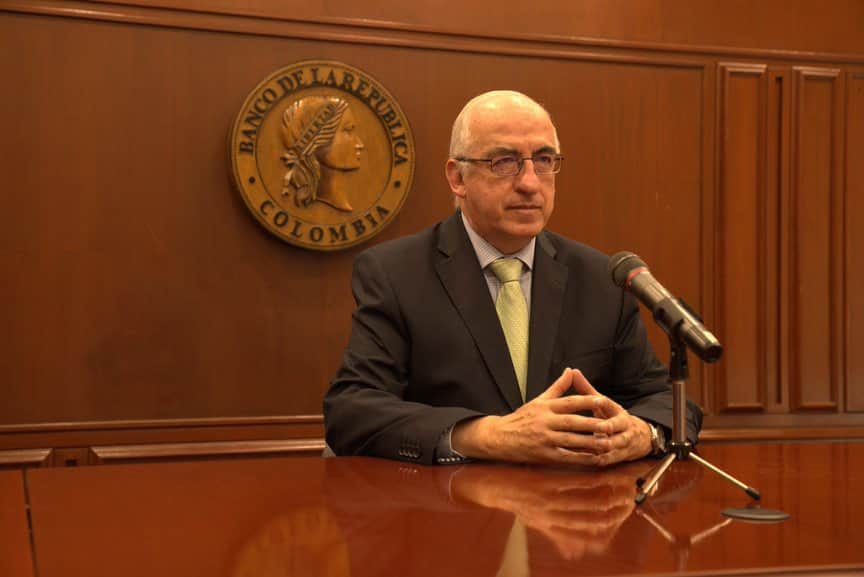Leonardo Villar Gómez, central bank governor of Colombia, speaks about Latin America’s interest rates and the economic outlook for Colombia.

Global Finance: What is the economic outlook for Colombia in the coming 12 months? What are the main risks?
Leonardo Villar Gómez: Currently, bringing inflation back to the target is the most important challenge for the central bank. Inflation increased from less than 2% to 13.1% between 2020 and 2022, the highest figure since the inflation targeting regime was adopted in the 1990s. Global and domestic supply shocks fueled this rise in inflation, but the rapid recovery in aggregate demand also pushed it up. GDP growth reached 11% in 2021 and 7.3% in 2022, along with a widening current account deficit. Additionally, a sharp depreciation of the Colombian peso, greater than that of most of its regional peers, contributed to this inflationary trend, coinciding with the deterioration in the perception of country risk among investors in the past two years.
Following strong monetary tightening by the central bank, which increased the policy interest rate by 11.5 percentage points between September 2021 and April 2023, inflation began a correction path in March, moving from an apparent peak of 13.3% to 11.8% in July. This trend is expected to continue, thus bringing inflation within our target range of 2% to 4% by the end of 2024.
Fiscal policy supports this effort by adhering to the fiscal rule. After three years of large deficits, the primary balance is expected to be zero in 2023 and reach a small surplus in 2024. Furthermore, the Colombian peso appreciated vis-à-vis the US dollar by nearly 15% so far this year, outperforming its regional peers and helping to reduce inflation.
However, there are several risks to the inflationary outlook. The high degree of price indexation in the Colombian economy creates inflationary inertia and hampers the effects of the monetary tightening. Furthermore, El Niño could drive up food and energy prices. Also, fuel price increases that were intended to bring them back to international parity, while necessary for fiscal sustainability, have had an impact on the CPI basket, causing a slower convergence toward the central bank’s target.
Regarding growth, the central bank forecasts a growth rate of 0.9% in 2023 and 1% in 2024. While this signals a period of slow growth, the recovery of the Colombian economy after the pandemic was extraordinary, and the country’s current production is at a level well above the pre-pandemic trend. This slowdown will help the Colombian economy achieve a more sustainable growth path and prevent the buildup of additional external imbalances.
GF: You started raising rates in Sept. 2021. Is that cycle over?
Villar: Although the policy interest rate has not been adjusted further in the last two board meetings, uncertainty is still high, and the central bank signaled that any future decision will be data dependent. There are several indications that aggregate demand is declining and that inflation will decrease in the remainder of 2023 and in 2024. However, returning to the inflation target by the end of next year is likely to require a contractionary monetary policy stance for a relatively long period of time. The possibility of reducing nominal interest rates will rely on the path of reduction for both observed and expected inflation.
GF: How strong is the Colombian banking sector?
Villar: The banking sector in Colombia is strong, thanks to robust regulation and supervision. Colombia’s financial regulation is in line with the international standards of Basel III, and applies to credit institutions regardless of their size. The central bank’s periodical stress tests, conducted by the Financial Stability Department, evidence a resilient financial sector even under extreme risk scenarios. The growth rate of the loan portfolio is slowing down, in line with tighter monetary policy and lower economic growth. Commercial credit continues to grow at positive rates. One of the medium-term challenges of the Colombian economy is to move toward a deeper financial system in a sustainable way.
GF: What keeps you up at night?
Villar: The central bank is focused on bringing inflation back to the 3% target. However, this process could be hindered by the high degree of indexation in the Colombian economy, inherited from the period of high inflation in the second half of the 20th century. The minimum wage, pensions, and leases are adjusted every year based on the previous year’s headline inflation, creating additional challenges for monetary policy. In addition, the strength and duration of El Niño are still uncertain, and could generate additional pressures on domestic food and energy prices.
Fortunately, inflation expectations for the two-year horizon have remained around 4%, highlighting the central bank’s credibility. The importance of a credible inflation target, the public’s understanding of monetary tightening, the short-term trade-offs between inflation and output, and the risks associated with inflation expectations becoming unanchored have all been critical considerations in the latest monetary policy decisions.



